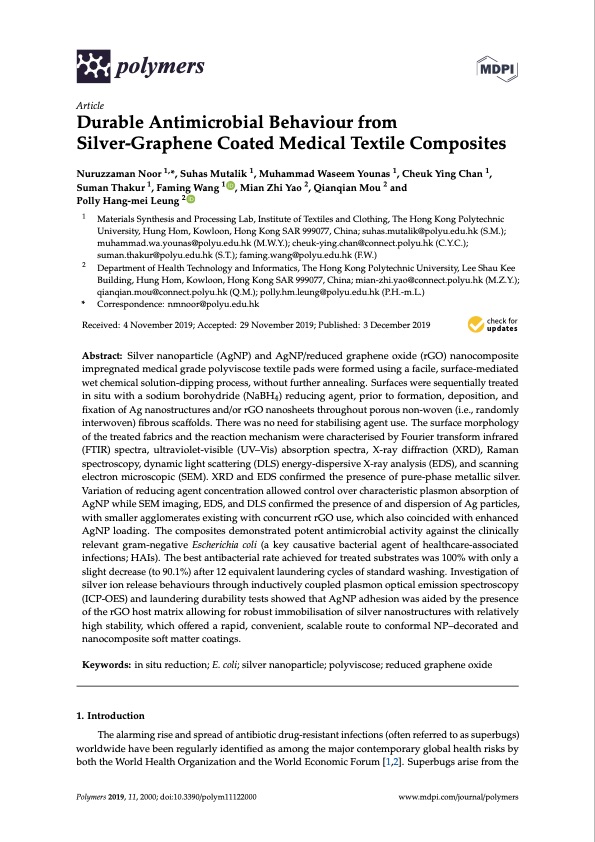
PDF Publication Title:
Text from PDF Page: 001
polymers Article Durable Antimicrobial Behaviour from Silver-Graphene Coated Medical Textile Composites Nuruzzaman Noor 1,*, Suhas Mutalik 1, Muhammad Waseem Younas 1, Cheuk Ying Chan 1, Suman Thakur 1, Faming Wang 1 , Mian Zhi Yao 2, Qianqian Mou 2 and Polly Hang-mei Leung 2 1 2 * Correspondence: nmnoor@polyu.edu.hk Received: 4 November 2019; Accepted: 29 November 2019; Published: 3 December 2019 Materials Synthesis and Processing Lab, Institute of Textiles and Clothing, The Hong Kong Polytechnic University, Hung Hom, Kowloon, Hong Kong SAR 999077, China; suhas.mutalik@polyu.edu.hk (S.M.); muhammad.wa.younas@polyu.edu.hk (M.W.Y.); cheuk-ying.chan@connect.polyu.hk (C.Y.C.); suman.thakur@polyu.edu.hk (S.T.); faming.wang@polyu.edu.hk (F.W.) Department of Health Technology and Informatics, The Hong Kong Polytechnic University, Lee Shau Kee Building, Hung Hom, Kowloon, Hong Kong SAR 999077, China; mian-zhi.yao@connect.polyu.hk (M.Z.Y.); qianqian.mou@connect.polyu.hk (Q.M.); polly.hm.leung@polyu.edu.hk (P.H.-m.L.) Abstract: Silver nanoparticle (AgNP) and AgNP/reduced graphene oxide (rGO) nanocomposite impregnated medical grade polyviscose textile pads were formed using a facile, surface-mediated wet chemical solution-dipping process, without further annealing. Surfaces were sequentially treated in situ with a sodium borohydride (NaBH4) reducing agent, prior to formation, deposition, and fixation of Ag nanostructures and/or rGO nanosheets throughout porous non-woven (i.e., randomly interwoven) fibrous scaffolds. There was no need for stabilising agent use. The surface morphology of the treated fabrics and the reaction mechanism were characterised by Fourier transform infrared (FTIR) spectra, ultraviolet-visible (UV–Vis) absorption spectra, X-ray diffraction (XRD), Raman spectroscopy, dynamic light scattering (DLS) energy-dispersive X-ray analysis (EDS), and scanning electron microscopic (SEM). XRD and EDS confirmed the presence of pure-phase metallic silver. Variation of reducing agent concentration allowed control over characteristic plasmon absorption of AgNP while SEM imaging, EDS, and DLS confirmed the presence of and dispersion of Ag particles, with smaller agglomerates existing with concurrent rGO use, which also coincided with enhanced AgNP loading. The composites demonstrated potent antimicrobial activity against the clinically relevant gram-negative Escherichia coli (a key causative bacterial agent of healthcare-associated infections; HAIs). The best antibacterial rate achieved for treated substrates was 100% with only a slight decrease (to 90.1%) after 12 equivalent laundering cycles of standard washing. Investigation of silver ion release behaviours through inductively coupled plasmon optical emission spectroscopy (ICP-OES) and laundering durability tests showed that AgNP adhesion was aided by the presence of the rGO host matrix allowing for robust immobilisation of silver nanostructures with relatively high stability, which offered a rapid, convenient, scalable route to conformal NP–decorated and nanocomposite soft matter coatings. Keywords: in situ reduction; E. coli; silver nanoparticle; polyviscose; reduced graphene oxide 1. Introduction The alarming rise and spread of antibiotic drug-resistant infections (often referred to as superbugs) worldwide have been regularly identified as among the major contemporary global health risks by both the World Health Organization and the World Economic Forum [1,2]. Superbugs arise from the Polymers 2019, 11, 2000; doi:10.3390/polym11122000 www.mdpi.com/journal/polymersPDF Image | Antimicrobial from Silver-Graphene Coated Medical Textiles

PDF Search Title:
Antimicrobial from Silver-Graphene Coated Medical TextilesOriginal File Name Searched:
polymers-11-02000-v2.pdfDIY PDF Search: Google It | Yahoo | Bing
Turbine and System Plans CAD CAM: Special for this month, any plans are $10,000 for complete Cad/Cam blueprints. License is for one build. Try before you buy a production license. More Info
Waste Heat Power Technology: Organic Rankine Cycle uses waste heat to make electricity, shaft horsepower and cooling. More Info
All Turbine and System Products: Infinity Turbine ORD systems, turbine generator sets, build plans and more to use your waste heat from 30C to 100C. More Info
CO2 Phase Change Demonstrator: CO2 goes supercritical at 30 C. This is a experimental platform which you can use to demonstrate phase change with low heat. Includes integration area for small CO2 turbine, static generator, and more. This can also be used for a GTL Gas to Liquids experimental platform. More Info
Introducing the Infinity Turbine Products Infinity Turbine develops and builds systems for making power from waste heat. It also is working on innovative strategies for storing, making, and deploying energy. More Info
Need Strategy? Use our Consulting and analyst services Infinity Turbine LLC is pleased to announce its consulting and analyst services. We have worked in the renewable energy industry as a researcher, developing sales and markets, along with may inventions and innovations. More Info
Made in USA with Global Energy Millennial Web Engine These pages were made with the Global Energy Web PDF Engine using Filemaker (Claris) software.
Infinity Turbine Developing Spinning Disc Reactor SDR or Spinning Disc Reactors reduce processing time for liquid production of Silver Nanoparticles.
| CONTACT TEL: 608-238-6001 Email: greg@infinityturbine.com | RSS | AMP |